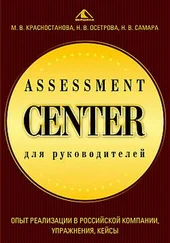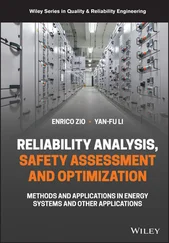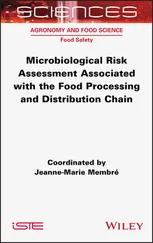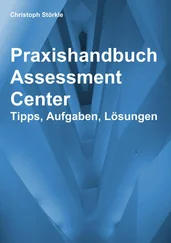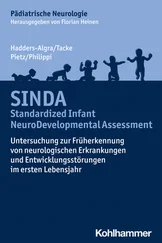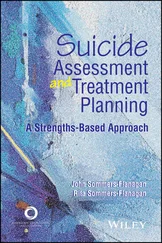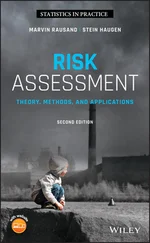Georgi Popov - Risk Assessment
Здесь есть возможность читать онлайн «Georgi Popov - Risk Assessment» — ознакомительный отрывок электронной книги совершенно бесплатно, а после прочтения отрывка купить полную версию. В некоторых случаях можно слушать аудио, скачать через торрент в формате fb2 и присутствует краткое содержание. Жанр: unrecognised, на английском языке. Описание произведения, (предисловие) а так же отзывы посетителей доступны на портале библиотеки ЛибКат.
- Название:Risk Assessment
- Автор:
- Жанр:
- Год:неизвестен
- ISBN:нет данных
- Рейтинг книги:4 / 5. Голосов: 1
-
Избранное:Добавить в избранное
- Отзывы:
-
Ваша оценка:
- 80
- 1
- 2
- 3
- 4
- 5
Risk Assessment: краткое содержание, описание и аннотация
Предлагаем к чтению аннотацию, описание, краткое содержание или предисловие (зависит от того, что написал сам автор книги «Risk Assessment»). Если вы не нашли необходимую информацию о книге — напишите в комментариях, мы постараемся отыскать её.
Explore the fundamentals of risk assessment with references to the latest standards, methodologies, and approaches Risk Assessment: A Practical Guide to Assessing Operational Risks
Risk Assessment: A Practical Guide to Assessing Operational Risks
Risk Assessment — читать онлайн ознакомительный отрывок
Ниже представлен текст книги, разбитый по страницам. Система сохранения места последней прочитанной страницы, позволяет с удобством читать онлайн бесплатно книгу «Risk Assessment», без необходимости каждый раз заново искать на чём Вы остановились. Поставьте закладку, и сможете в любой момент перейти на страницу, на которой закончили чтение.
Интервал:
Закладка:
2 Have the risk assessment system to be installed fits the needs of the organization. Avoid complexity if that can be done. It is better to have a noncomplex system that works than to have a complex system that does not.
3 The leadership and commitment necessary at sufficiently high levels to achieve the change must be obtained.
4 Determine how people who do the work are to be involved and how.
5 Align the risk assessment process with other stated organizational values.
6 Safety professionals, the change agents, must recognize the magnitude of the culture change they propose and be patient as they proceed.
7 Select risk assessments to be made, at first, where the outcomes will be beneficial and evident.
8 Team building – vital to success – must be sufficient.
9 To obtain the views of interested parties, consider holding an open house or establishing a focus group. These activities can have other payoffs as well.
10 Prepare for the typical resistance to change at all levels. Preparation must not come up short.
11 Communication to all personnel levels that would be affected by the change should be as thorough as needed.
12 Try to use the wording in presenting the risk assessment system and when introducing it to people who do the work that fits with their internal shorthand.
13 It is best to start with a limited number of clear objectives (say, three to five) and then expand the list over time. Keep your objectives simple initially, gain some early successes, and then build on them.
14 Measurable objectives should be consistent with the overall organizational mission and its policy.
15 Regularly communicate progress in achieving objectives to whom the safety professional reports, at staff meetings and throughout the organization, if appropriate.
16 Management personnel who are assigned responsibility for the change should be held accountable for progress by the people to whom they report.
17 Over time, the urgency and importance of the change may diminish and that should be anticipated and countered.
18 Be aware that it is typical for assumptions to be are made that a change in a process or a system has occurred when it actually has not. (This is called declaring victory too soon.)
19 Keep a tracking file suitable to the organization.
In the literature, some writers say that a change in a system or process should not be considered a success as a culture modification until the change has been in place for at least a year. It occurs too often that operators revert to previous methods or ignore the new system if supervision allows such regression.
Activities at the ASSP (Critiqued and approved By Tim Fisher at the ASSP)
In the late 1980s and early 1900s, organizations in the United States and throughout the world began to shift toward more risk‐based decision‐making to improve overall safety performance and reduce incidents of serious injuries, illnesses, and fatalities.
This was coupled with the fact that regulators in certain regions began adopting more risk‐based approaches. The concept began to really pick up steam and move forward after 2010 as ASSP volunteers put their collective resources and expertise into high‐caliber technical reports and standards.
For many decades in occupational safety and health, businesses and industries around the world were arguably more focused on regulatory compliance and task management centered instead of managing risks. As time went on and illnesses, injuries, and fatalities metrics plateaued, it was clear that something needed to change in order to achieve real progress.
As an example, data from the Bureau of Labor Statistics show that, from 2003 to 2016, the level of fatal occupational injuries maintained relatively steady. This indicates that there is still more work to do to educate safety professionals and business executives on the importance of identifying hazards and focusing on risk assessment, avoidance, and control.
A risk‐based strategy serves many purposes, the foremost of which is identifying potential hazards and risks associated with an operation so that proper controls can be put in place. Once the risk is understood, organizations can develop a number of options for mitigating or eliminating hazards and risks. Safety professionals can play a key role in the process if they are able to facilitate the analysis and identify practical solutions.
A properly designed risk assessment will also effectively communicate to decision‐makers the impact these risks could have on the organization, both from a safety standpoint and on the bottom line. Although progress has been made among safety professionals and business leaders in utilizing risk‐based decision‐making, many are still along the continuum of maturity from compliance to improved performance through risk assessment. To this day, the level of expertise about risk assessment and how risk is viewed varies from region to region.
1.2.1 Approach Taken at the ASSP
Several Occupational Safety and Health Professionals who were active in the ASSP recognized that requirements for risk assessment were more frequently included in safety‐related standards and guidelines and that the ASSP should provide its members with educational opportunities through which the necessary skills could be acquired. A presentation on the subject was made at the ASSP/ASSP February 2013 Board of Directors meeting, the outcome of which was the creation of a Risk Assessment Institute and an ASSP Risk Assessment Committee.
One of the key issues leading to the formation of the committee was for its members to work on literature, videos, webinars, and other materials that could be presented at chapter meetings and at conferences. The significance of these activities is that increased awareness had developed among the leaders of ASSP, a professional and technical organization with an international scope that its members would be well served if they were provided means to acquire risk assessment skills. This is an important step forward for the practice of safety.
Risk assessment is a formal process for identifying hazards, evaluating and analyzing risks associated with those hazards, then either eliminating the hazards or controlling those risks that cannot be eliminated to minimize injury and illness potential. It is critical to proactively prioritize and mitigate risk in advance of injuries or catastrophes.
1.2.2 ASSP Risk Assessment Committee
Throughout, our Risk Assessment Committee (ASSP) has aimed to include risk assessment into an organizational risk process, allowing businesses to be proactive in prioritizing and mitigating risk in advance of injuries or catastrophes. By understanding and implementing risk‐based approaches to safety management, injury/illness prevention, and employee well‐being, occupational safety professionals help their organizations improve overall performance and position themselves as high‐profile contributors who help organizations achieve their goals.
1.2.3 The Goals
Through its work and initiatives, the Risk Assessment Committee pursues four distinct goals:
1 Educate executives, the business community, and occupational safety and health professionals on the value of the risk assessment approach and ways to successfully implement risk assessment.
2 Improve risk‐related training and education for occupational safety and health professionals so they can better understand the risk‐based decision‐making process and improve core risk assessment competencies.
3 Provide a platform for the occupational safety community to contribute to the development of new evidence‐based risk‐related policies, processes, and solutions. We seek ways to leverage the expertise of the occupational safety and health community in identifying and quantifying risk, advance risk‐related regulatory and legislative initiatives related to the management of risks, and identify relevant research related to understanding risks.
Читать дальшеИнтервал:
Закладка:
Похожие книги на «Risk Assessment»
Представляем Вашему вниманию похожие книги на «Risk Assessment» списком для выбора. Мы отобрали схожую по названию и смыслу литературу в надежде предоставить читателям больше вариантов отыскать новые, интересные, ещё непрочитанные произведения.
Обсуждение, отзывы о книге «Risk Assessment» и просто собственные мнения читателей. Оставьте ваши комментарии, напишите, что Вы думаете о произведении, его смысле или главных героях. Укажите что конкретно понравилось, а что нет, и почему Вы так считаете.

